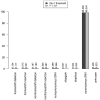Exploring Impact of Rare Variation in Systemic Lupus Erythematosus by a Genome Wide Imputation Approach
- PMID: 30863397
- PMCID: PMC6399402
- DOI: 10.3389/fimmu.2019.00258
Exploring Impact of Rare Variation in Systemic Lupus Erythematosus by a Genome Wide Imputation Approach
Abstract
The importance of low frequency and rare variation in complex disease genetics is difficult to estimate in patient populations. Genome-wide association studies are therefore, underpowered to detect rare variation. We have used a combined approach of genome-wide-based imputation with a highly stringent sequence kernel association (SKAT) test and a case-control burden test. We identified 98 candidate genes containing rare variation that in aggregate show association with SLE many of which have recognized immunological function, but also function and expression related to relevant tissues such as the joints, skin, blood or central nervous system. In addition we also find that there is a significant enrichment of genes annotated for disease-causing mutations in the OMIM database, suggesting that in complex diseases such as SLE, such mutations may be involved in subtle or combined phenotypes or could accelerate specific organ abnormalities found in the disease. We here provide an important resource of candidate genes for SLE.
Keywords: GWAS—genome-wide association study; SLE; aggregated case-control enrichment; imputated rare variation; sequence kernel association test; systemic lupus erythematosus.
Figures




Similar articles
-
Review of recent genome-wide association scans in lupus.J Intern Med. 2009 Jun;265(6):680-8. doi: 10.1111/j.1365-2796.2009.02096.x. J Intern Med. 2009. PMID: 19493061 Review.
-
Investigation of systemic lupus erythematosus (SLE) with integrating transcriptomics and genome wide association information.Gene. 2019 Jul 20;706:181-187. doi: 10.1016/j.gene.2019.05.004. Epub 2019 May 11. Gene. 2019. PMID: 31082500
-
Several Critical Cell Types, Tissues, and Pathways Are Implicated in Genome-Wide Association Studies for Systemic Lupus Erythematosus.G3 (Bethesda). 2016 Jun 1;6(6):1503-11. doi: 10.1534/g3.116.027326. G3 (Bethesda). 2016. PMID: 27172182 Free PMC article.
-
De novo mutations implicate novel genes in systemic lupus erythematosus.Hum Mol Genet. 2018 Feb 1;27(3):421-429. doi: 10.1093/hmg/ddx407. Hum Mol Genet. 2018. PMID: 29177435 Free PMC article.
-
Genetics research in systemic lupus erythematosus for clinicians: methodology, progress, and controversies.Curr Opin Rheumatol. 2010 Mar;22(2):119-25. doi: 10.1097/BOR.0b013e3283361943. Curr Opin Rheumatol. 2010. PMID: 20035223 Review.
Cited by
-
LASSO-derived nomogram for early identification of pediatric monogenic lupus.World J Pediatr. 2024 Nov;20(11):1155-1167. doi: 10.1007/s12519-024-00817-y. Epub 2024 Jul 6. World J Pediatr. 2024. PMID: 38970732 Free PMC article.
-
Single Nucleotide Polymorphism rs6445975 in the PXK Gene Is Correlated with Susceptibility and Clinical Characteristics of Systemic Lupus Erythematosus.Iran J Public Health. 2022 Aug;51(8):1866-1874. doi: 10.18502/ijph.v51i8.10273. Iran J Public Health. 2022. PMID: 36249102 Free PMC article.
-
Nucleic Acid Immunity in the Pathogenesis of Cutaneous Lupus Erythematosus.Front Immunol. 2019 Jul 16;10:1636. doi: 10.3389/fimmu.2019.01636. eCollection 2019. Front Immunol. 2019. PMID: 31379837 Free PMC article. Review.
-
New Horizons in the Genetic Etiology of Systemic Lupus Erythematosus and Lupus-Like Disease: Monogenic Lupus and Beyond.J Clin Med. 2020 Mar 5;9(3):712. doi: 10.3390/jcm9030712. J Clin Med. 2020. PMID: 32151092 Free PMC article. Review.
-
Emerging roles of rare and low-frequency genetic variants in type 1 diabetes mellitus.J Med Genet. 2021 May;58(5):289-296. doi: 10.1136/jmedgenet-2020-107350. Epub 2021 Mar 22. J Med Genet. 2021. PMID: 33753534 Free PMC article. Review.

